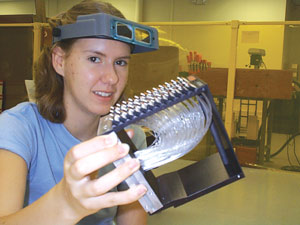By Ernie Tretkoff
 Photo Credit: LeRoy Castle The young woman in the photo is Erin McCamish, and she is holding an optical decoder unit for the CMS hadron calorimeter that she assembled. The summer this picture was taken, she was a student at Lake Shore High School in Stevenville, MI. Now she is at the University of Michigan studying physics. |
"We think it's really one of the most valuable physics education programs that we have," said Judy Jackson, head of public affairs at Fermilab, "It brings so many different players into the mix. It's a great way of bringing in people from a wide geographic area."
Here's how the QuarkNet program works: First, after a weeklong orientation at Fermilab, selected high school teachers spend a summer doing research with a physicist-mentor from a local university or laboratory. The teachers might work on experiments at CERN or Fermilab, or at their mentor's lab.
After their research summer, the teachers try to integrate some of what they learned into their classroom. Rather than teaching a separate unit on particle physics, many teachers find they can integrate particle physics into lessons on basic concepts such as conservation of momentum and energy.
Also during the school year following their research summer, the QuarkNet teachers, along with their mentors, develop a three-week research-based program for up to ten more "associate" teachers. The following summer, the lead teachers and their mentors present their three-week program at their QuarkNet center, the university or lab where the mentor researchers work.
"Our goal in essence is to help teachers learn how scientists work, and look at the way they can bring those work skills into their classroom so that their students begin to model research in the classroom," said Marge Bardeen, manager of the Fermilab education office and spokesperson for QuarkNet. QuarkNet also aims to get teachers a more "inquiry-based" approach that involves hands-on projects rather than the traditional lecture format. Several teachers have indeed changed the way they teach.
For example, Jeff Dilks, a teacher in Iowa, conducted an experiment with his high school class, and found that he had meaningless data. Before QuarkNet, he would have just moved on to the next topic, but instead he realized that scientists wouldn't do that. So the next day, he had the students think about how they could change the experiment to improve the data. The class reran the experiment and got better results.
Dilks also found that the QuarkNet program has earned him, and his subject, new respect at his school. " There's a new interest in what's going on in physics. Administrators ask what I'm doing. Secretaries provide me with newsclippings. Physics has a much higher profile around my school," he said.
Another QuarkNet teacher, Deborah Roudebush of northern Virginia, designed her entire physics class around the theme of the search for the Higgs boson. She taught the standard high school physics topics, but always introduced the concepts in the context of how they would apply in the search for the Higgs.
The physics researchers also benefit from the QuarkNet program. Randy Ruchti, a Project Principal Investigator and QuarkNet mentor, appreciated the chance to expand his research group to include the teachers, and he said he learned a lot from them. "First of all, I've learned that among the difficulties teachers face, many are teaching to a test, so there is very little time to do any inquiry." Ruchti participates in the program because he believes that "practicing scientists have an obligation to reach down to attract young people into science."
Ruchti also said QuarkNet is working to include more traditionally underrepresented groups, especially by attracting teachers who work in inner city schools.
Since QuarkNet began in 1999, nearly 500 high school teachers have participated in the program, either as lead teachers or associate teachers. About 50 centers are now operating across the country. The program plans to expand to include about 60 centers, and will reach over 700 teachers. Some of the centers that have been operating for several years are now expanding to include several high school students in a summer of research at the center. One of the reasons the program has been so successful, said Bardeen, is that it is run by a staff of teachers. "I always feel it's important to put teachers in leadership positions," she said, "They have not only the understanding of what teachers face in the classroom, but they also have credibility."
©1995 - 2024, AMERICAN PHYSICAL SOCIETY
APS encourages the redistribution of the materials included in this newspaper provided that attribution to the source is noted and the materials are not truncated or changed.
Associate Editor: Jennifer Ouellette
June 2004 (Volume 13, Number 6)
Articles in this Issue

